
James, age 9 from Tasmania, works in Don's worksheet book via his Math By Mail/Email & AIM
James' Mom, Carolyn, after looking at Don's worksheet book said, "The thing I liked best about Don's book is the way he encourages mistakes and alternative answers. We are very alternative".
From June 21:

June 24, 2001 James was working on pp. 11-13 in Don's worksheet book and made a table of the place values in different bases (there should be a 1 in the ones column for every base). he scanned these sheets and sent them to Don as attached files. One he sent as an AIM file.
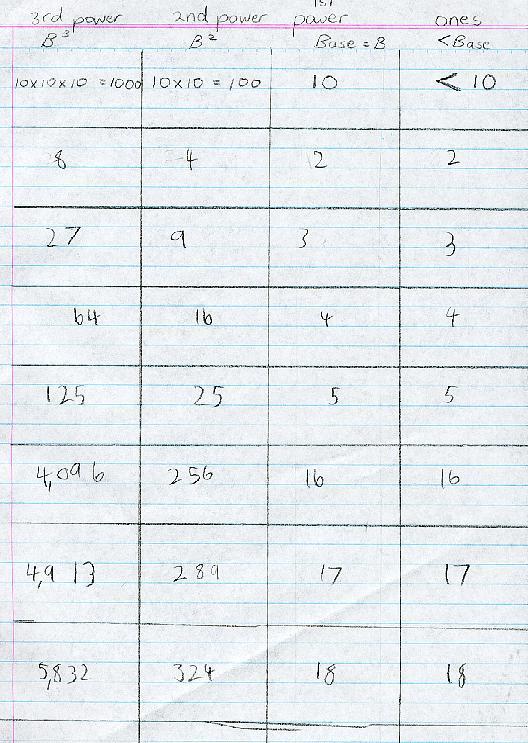
James made a code for writing numbers in base 5.
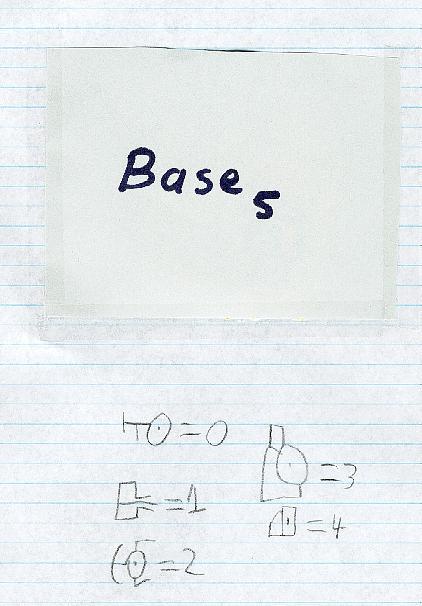
Then he sent Don the following problem to change the numeral in his base 5 code to our base ten:

Don wrote this as 2100 (base 5) and equals 2x125 + 1x25 + 0x5 + 0x1 = 250 + 25 = 275 (base 10). And James over the voice using AIM told Don this was correct. Then Don gave James the following numeral in binary 11011 (base 2) to change to decimal. James came back quickly with 11011 (base 2) = 27 (base 10). Fine job James!
At this point in James' and Don's communications: James wants to do his work in Don's book first thing in the morning and Carolyn is very pleased with what James is doing.
From James on July 11, 2001 after 2 weeks of bronchitis; his graph of the partial sums for 1/2 + 1/4 + 1/8 ...
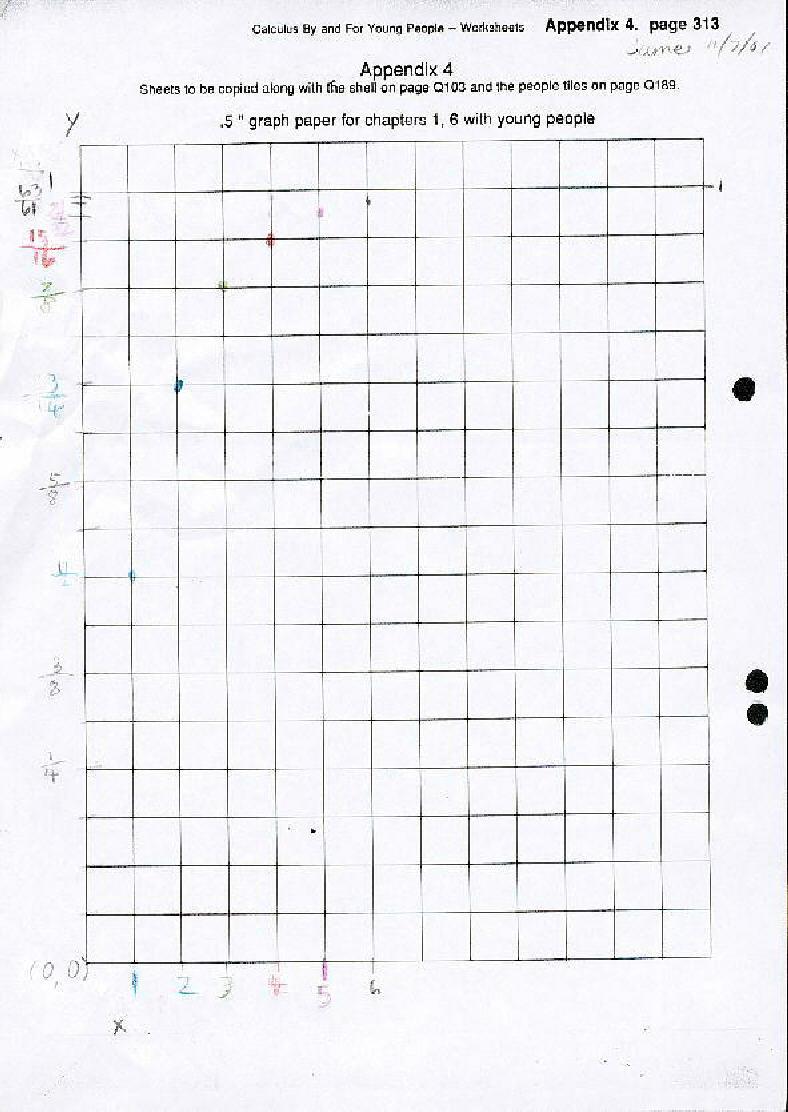
July 19, 2001: Carolyn
and Don had arranged this session by email. On AIM,
James played the "Guess My Number" game with Don. James and his Mum
had Don get Sheri's
page on his screen. Then James asked Don which cards contained his number
and he successfully found Don's number. Then Don found James' number. James
graphed x+y=9 (because he is 9), scanned it and sent this to Don in AIM:
On AIM, Don had James find the coordinates for (10, -1) which he did and Don had him add 10 + -1 = 9 which he did. Don spent time talking with Carolyn about how the negatives should be written with the sign raised . Most textbooks after more than 30 years that we write it correctly, still write the negative number with a minus sign, then they need parentheses around it like 10 + (-1) = 9, and it gets very complicated. Don pointed this out to Carolyn on page 108 in his worksheet book, which they have near the computer. Carolyn communicated this to James. Then Don asked him to get the coordinates of a point between points on the graph. He found 2 1/2 and 6 1/2 and added them to get 9. Sometimes Don spoke to James and sometimes to his Mum, Carolyn.
Then James scanned and sent on AIM the
table he extended for the "Guess My Rule" game on p. 87 in Ch. 6 of
Don's worksheet book, which he figured out to be 2x+3=y. Don said he had a new
rule for James to figure out. (It was 3x-2=y) Don asked for a number to
put into his machine. James said 100, Don gave him back 298. At that point James
said Don's rule was 2x+98=y because 2x100+98=298. Of course that works for
his rule. Then Don asked James to try another number. He gave 10 and Don gave
him back 28. There was dead silence for about a minute and James wrote 3x-2=y !
Don wrote YES! and James came back with
YYYYYAAAAAAYYYYY!!! Everyone jumped with joy and clapped! Don left 4
things for James to work on: 1/3 + 1/9 +... in Ch. 1, the cookie sharing in Ch.
2, graphing 2x+3=y on p. 92 in Ch. 6, and solving equations on p. 145 in Ch. 8.
Despite the sound breaking up some, it was a very exciting session! Great
work James!
July 26,'01 Hi Carolyn,
Have fun!
Cordially, Don
July 29, 01 Dear
Don,
sorry no Idea what happened. The whole AIM thing dropped
off and then refused to reconnect. it hooked up again ok after I shut down and
rebooted.
Today ( friday ) I have to babysit friend's children ( she forgot the school is
closed today ) so we can't be online - i'm taking them out to go cave exploring!
That is such a lovely photo of you
and Tessa - did Marilyn take it? I never
cheers, Carolyn
1. 2*x + 8 = 24 + 10
2. 2*x + 8 = 34 + 10
3. 2*x + 4 = 44
he says that x=13 for number 1 but after I got really
confused when he said the
2*x + 8=24 then adding ten to get the next one
2*x + 8=34 then altering the other side by 4 while still
stepping up by ten on
2*x + 4=44
but now Michael is sick!
cheers,
Carolyn
Don talked with Carolyn about keeping the equations simple, like 2x+3=17 and referred her to p. 145, in ch.8 in his book.
james was doing page 88 Guess my rule today. he also found an old series he
did a few days ago and said it was "double it add 3" well how do you
say that in mathematical language? "Two times, no - two ecks plus three
equals Y. wow I didn't know I could say that!"
I'll send the graph later
cheers,
Carolyn sent James' graphs from p92 in Don's worksheet book.
Don sent via AIM, 3 graphs for James to write the equations for:
August 8, '01 On AIM Carolyn told Don James had figured out the cards for The Magic Number game for base 3. On the original 5 cards in binary, they went up to 31 (1 less than 32, a power of 2). James thought going up to 26 (1 less than 27, a power of 3) would be too small, and 80 (1 less than 81, the next power of 3) would be too large. He decided to go to 38. [One of Don's students on Aug. 13, ended up at 56 for the same problem!]
During this session on AIM, Don's students came in for class at that time. Amanda talked with Carolyn and the other student could hear her from Tasmania, on Don's speakers. Carolyn told us it was her birthday (it was Aug. 9, their time as we talked). We all sang Happy Birthday to her!
Then Don signed off for an hour to work with his students here. We he went back on AIM, this went on:
Carolyn:
so
really he's still having trouble writing equations to describe what he sees
happening on the graph
[James then
came on the microphone and the computer with AIM, and below is
essentially the written conversation
which was saved from AIM, with the oral
conversation going on at the same time (which you can't see or hear)!]
Don:
ok
Don:
2x+ ? = y
Don:
crosses the y-axis at 0,7
James:
2x+7=y
Don:
the equation is 2x+7=y
Don:
right
James:
but i still don't get it
Don:
horizontal axis is x-axis
James:
y=7?
Don:
when x=0, y = 7
James:
so
2x+7=7
James:
2x+7=y
Don:
when x=0, y=7
James:
ok
Don:
when x=1, y=9
James:
9 or
8?
forthferalz
: 2
Don:
8 is right [Don
makes a mistake here!]
Don:
sorry
James:
so
x-i,y=8 [James meant when x=1, y=8]
James:
opps
Don:
yes
James:
===========================
Don:
when x=2, y=9
James:
9
Don:
ok?
James:
y is
olways 7 more than x right?
Don:
when x=2, y=11
James:
you mean James [Don called James, Michael,
his brother's name]
Don:
2x+7=y
James:
yep
Don:
when x=2 , 2x2+7=11
Don:
when x=3, y=?
James:
its
two times x + 7=y
James:
13
James:
ok
Don:
ok
James:
oatmeal??
Don:
my brain is oatmeal
James:
i
eat that stuff
James:
ib
James:
ok
Don:
that's 1b
Don:
over 3 up 1
Don:
the first number is 1/3
James:
1
over 3
Don:
1/3
James:
1
third
Don:
is the first number
James:
ok
Don:
so the equation is 1/3 x + 5 = y
James:
1
third of x + 5 = y right?
Don:
yes
James:
okkkkkkkkkkkkkkkkkkkkkkkkkkkkk
9/6/01
Hi Don,
Can we stop for a fortnight? They have school holidays next week. James did some stuff today. Sending it later. I would like to get into more of a routine where he does a tiny bit everyday and we chat online once a fortnight, or where he does a lot intensively for a few days once a month. He's quite slow and he has a lot of other 'regular' maths to learn too.
David is keen to do some stuff - he has tried the stuff on page 15 too but can't see how it goes to a half.
Carolyn
9/6/01
Dear Don,
late reply - OK? Have James start the quadratic equations. Did he find the equation for graph #3? [no]. Did he check graph #2? [no] Start on fibonacci numbers p129. [Maybe next month!]
How about starting with a 9 by 9 square on the graph paper and work on 1/3 + 1/3 of 1/3 + 1/3 of 1/3 of 1/3 ... (or 1/3 + 1/9 + 1/27...) [ok he's done that. but I'm pretty sure it's not all that clear to him what you want - at first he started colouring in a quarters of a squares by accident
- he didn't draw a nice obvious square outlined thickly in black and I think he just sort of got 'lost'. And he had some pretty strange answers for the questions initially. i'm not sure what he was thinking of. he thought the partial sums progress to one, then he thought it goes to 243.
however he saw a pattern in the colouring in and cut out his shape and rearranged them to get oblongs stacking to the left and cubes stacking on the right. So we worked through it and it is clearer now i hope. using his graph he can see that if you draw a diagonal line that cuts from the top L corner to the bottom R and cut out the little end of the oblongs that stick over the line they fit next to the square of the next term and the whole series will never cross the halfway line.
cheers,Carolyn
might chat to you online tonight
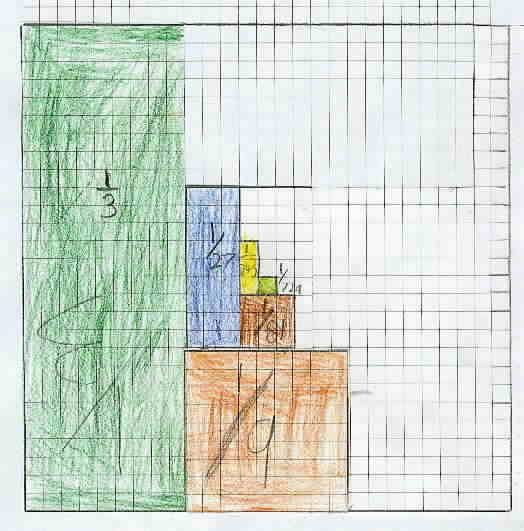
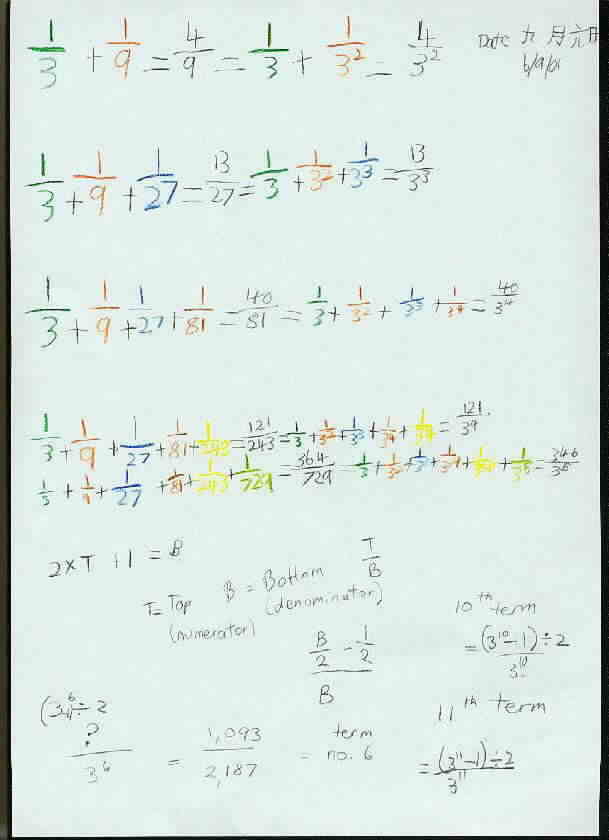
Notice the date written in the upper right corner was 6/9/01. That is the 6th day of the 9th month of the year 2001.
September 30, 2001
Carolyn sent Don James' graph below via AIM. Carolyn and Don talked about the patterns in the parabola, the curve, x*x=y.
Don suggested to Carolyn
1.) that James make his graphs so the origin (0,0) is not in the lower left
corner so he could plot negative numbers for x.
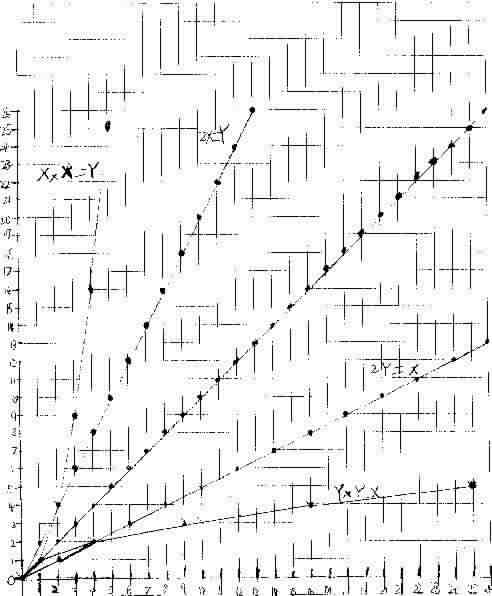
2.) The slope of the parabola
changes, which makes it a curve, not a straight line when the slope is the same
everywhere. Starting at (0,0), you go over 1 to the right and up 1 to get
to the next (integral) point. From (1,1) you go1 to the right and 3 up. Then
from (2,4) you go1 to the right and 3 up, then 5 up, then 7 up and so on. Why
because 1+3=4=22 and 1+3+5=9=32 ,.., so the sum of the odd
numbers is a square number- and x*x = x2 , a square.
3.) Don worked with James about multiplying negative numbers because Don wanted
him to graph x*x=y when x= -3. So what is -3 x -3?
Don used the pattern below from Sheri's page to help James get -3 x -3
= 9.

3.) It was James' idea to switch the x and y
and graph y*y=x. That was a great idea James!
4.) Don worked with Carolyn on the differences in the y's, then the differences
in the differences, which are all 2. The differences in consecutive odd numbers
is 2. And the fact that the 2nd difference
is constant, means the function is 2nd
degree (x2).